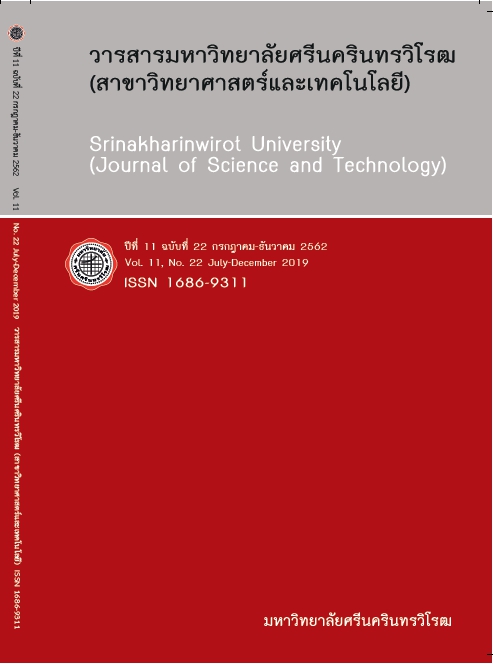ปริมาณสารประกอบฟีนอลทั้งหมดและปริมาณแกลลิกในผลมะขามป้อมสด และผลมะขามป้อมดองจากห้าแหล่งสายพันธุ์ (TOTAL PHENOLIC AND GALLIC ACID CONTENTS IN FRESH AND PRESERVED EMBLICA OFFICINALIS GAERTN FRUITS FROM FIVE DIFFERENT VARIETIES)
Keywords:
Emblica Officinalis Gaertn, Euphorbiaceae Family, Gallic Acid, Total Phenolic Content, HPLC AnalysisAbstract
Emblica officinalis Gaertn has been used in traditional medicine for treatment of various diseases in Asian countries. It has been recorded in Ayurvedic and traditional medicines in Thailand for health tonic and one of its recipe was recently reported on cancer treatment. Gallic acid, an active compound from E. officinalis fruit varaints, has revealed on research against oxidative diseases and used in pharmacological manufacturing. This study was aimed to analyze gallic acid and total phenolic phytoconstituents in E. officinalis Gaertn fruits from five difference varieties in both fresh and their preserved in 10% and 15% NaCl solution during three months storage time. The five fruit pulps from KR-1, KR-2, KR-3, KR-4 and LTK-3 were separated from the seeds, then have been dried and powdered, respectively. The powder was extracted by using absolute ethanol. Gallic acid content was evaluated in all extracts by using HPLC apparatus.The results revealed that KR-4 variety contained the lowest gallic acid content whereas the highest content was obtained in LTK-3 variety. Gallic acid and phenolic contents were increased from week 0 to 12.
The further research will focus on food products, pharmaceutical evaluation and cosmetics in the LTK-3 variety.
Downloads
References
[2] Maurya, U., and Srivastava, S. (2011). Traditional Indian herbal medicine used as antipyretic, antiulcer, anti-diabetic and anticancer: A review. International Journal of Research in Pharmaceutical Chemistry. 1, 1152-1159.
[3] Wongnoppavich, A., Jaijol, K., and Sireeratawong, S. (2009). Triphala The Thai traditional herbal formulation for cancer treatment. Songkla-nakari J.Sci.Technol. 31, 139-149.
[4] Srivasuki K.P. (2012). Nutritional and health care benefits of Amla. Journal of Pharmacognosy. 13,141-151.
[5] Zhang, L.Z., Zhao, W.H., Guo, Y.J., Tu, G.Z., Lin, S., and Xin, L.G. (2008). Studies on chemical constituents in fruits of Tibetan medicine Phyllanthus emblica. ZhongguoZhong Yao ZaZhi. 28, 940-943.
[6] Singh, E., Sharma, S., Pareek, A., Dwivedi, J., Yadav, S., and Sharma, S. (2011). Phytochemistry, traditional uses and cancer chemopreventive activity of Amla (Phyllanthus emblica): The Sustainer. J. of Applied Pharmaceutical Science. 2, 176-183.
[7] Sawant, L., Prabhakar, B., and Pandita, N. (2010). Quantitative HPLC analysis of ascorbic acid and gallic acid in Phyllanthus Emblica. Journal of Analytical & Bioanalytical Techniques. 1, 1-4. DOI:10.4172/2155-9872.1000111
[8] Rakesh, A.S.S., and Moond, S.K. (2001). Processing products of aonla. Processed Food Industry.7, 20-23.
[9] Bhattacherjee, A.K., Dikshit, A., Kumar, S., and Tandon, D. (2012). Quality of aonla juice as affected by storage temperature. Beverage and Food World. 39, 54-56.
[10] Ruenroengklin, N., Zhong, J., Duan, X, Yang, B. Li, J., and Jiang, Y. (2008). Effects of various temperaures and pH values on the extraction yield of phenolics from Litchi fruit pericarp tissue and the antioxidant activity of the extracted anthocyanins. Int. J. Mol. Sci. 9, 1333-1341.
11] Reblova, Z. (2012). Effect of temperature on the antioxidant activity of phenolic acids. Czech J. Food Sci. 30, 171-177.
[12] Moldovan, B., and David, L. (2014). Influence of temperature and preserving agents on the stability of Cornelian cherries anthocyanins. Molecules. 19, 8177-8188.
[13] Barbosa, F.S., Leite, G.L.D., Martins, E.R.D., Avila, V.A., and Cerqueira, V.M. (2013). Medicinal plant extracts on the control of Diabrotica speciosa (Coleoptera Chrysomelidae). Rev. Bras. PI. Med. Botucatu. 15, 142-149.
[14] Nasr, C.B., Ayed, N., and Metche, M. (1996). Quantitative determination of the polyphenolic content of pomegranate peel. Zeitschrift fur Lebensmittel-Untersuchung und-Forschung. 203, 374-378.
[15] Govindarajan, R., Singh, D.P., and Rawat, A.K.S. (2008). Validated reversed-phase column high performance liquid chromatographic method for separation and quantification of polyphenolics and furocoumarics in herbal drugs. Journal of AOAC International. 91, 1020-1024.
[16] McQuate, R.S., Kraska, and R.C., Bidlack, W.R. (2009) Emblica officinalis extract-CAPROS foodusage conditions for general recognition of safety. Gras Assessment. 1-136.
[17] Luo, Q., Zeng, S., Shu, Y., Fu, Z., Zhao, H., and Su, S. (2018). A novel green process for tannic acid hydrolysis using an internally sulfonated hollow polystyrene sphere as catalyst. RSC Adv. 8, 17151-17158.
[18] Ossipova, V., Salminen, J.-P., Ossipova, S., Haukioja, E., and Pihaja, K. (2003). Gallic acid and hydrolysable tannins are formed in birch leaves from an intermediate compound of the shikimate pathway. Biochem. System. Eco. 31, 3-16.
[19] Belur, P.D., and Mugeraya, G. (2001). Microbial production of tannase: the state of art. Research Journal of Microbiology. 6, 25-40.
[20] Reddy, B.S., and Rathod, V. (2012). Gallic acid production & tannase activity of Penicilium purpurogenum stoll employing agro beased wastes through solid state fermentation: Influence of pH and temperature. Asian Journal of Biochemical and Pharmaceutical Research. 2, 59-62.
[21] Shete, H.G., and Chitanand, M.P. (2015). Bioconversion of naturally occurring tannins into a value added pharmaceutical intermediate gallic acid a new approach. Int. Curr. Microb. Appl. Sci. 4, 597-604.
[22] Bourgou, S., Bettaieb, I., Hamrouni, I., and Marzouk, B. (2012). Effect of NaCl on fatty acids, phenolics and antioxidant activity of Nigella sativa organs. Acta Physiol. Plant. 34, 379-386.
[23] Zhang, Y., Tang, N., Huang, L., Tang, X., and Wang, K. (2018). Effect of salinity stress on plant growth, antioxidant capacity, gland trichrome density, and volatile exudates of Schizonepeta tenuiflia Briq. Int. J. Mol. Sci. 19, 252. DOI:10.3390/ijms19010252
Downloads
Published
How to Cite
Issue
Section
License
Srinakharinwirot University Journal of Sciences and Technology is licensed Under a Creative Commons Attribution-NonCommercial-NoDerivs 4.0 International (CC-BY-NC-ND 4.0) License, Unless Otherwise Stated. Please Read Journal Policies Page for More Information on Open Access, Copyright and Permissions.



